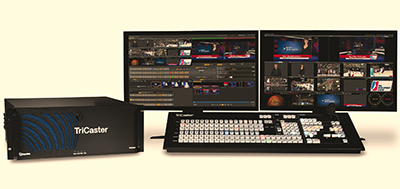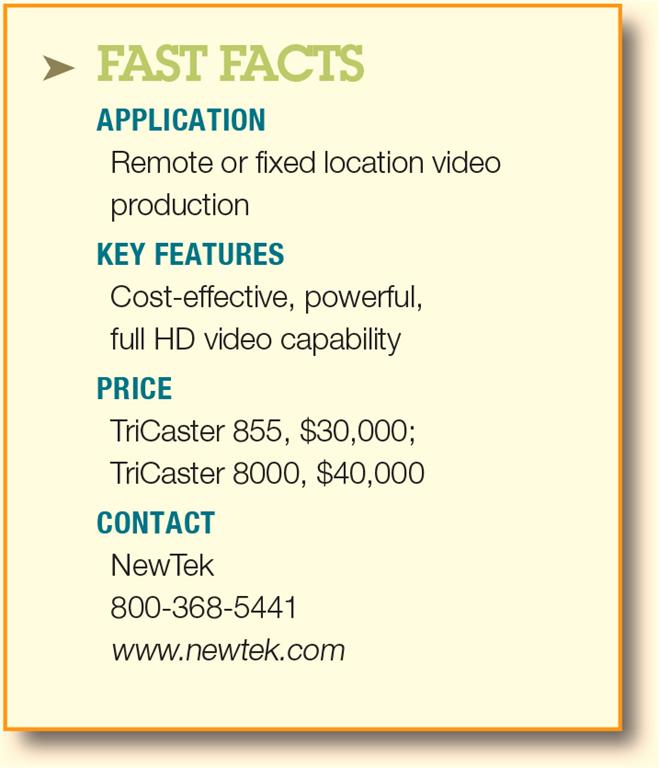NewTek TriCaster 855 Production Switcher
While remote production switchers have been around for decades, new models make the old ones almost laughable. One of the leading manufacturers in that field, San Antonio-based NewTek, is offering its own star, the Tricaster 855 (and the later model 8000).
It’s no news that the face of broadcast technology is changing. As a matter of fact, I think we would all admit that nothing is really produced just for “broadcast” any longer. The more recent term— “broadercasting”—pretty much sums it up, and with the NewTek TriCasters’ ability to send simultaneously to all media platforms, they really are “broader casters.”
FEATURES
The heart of the Tricaster 855 is a 4RU rackmount chassis with a 550 W redundant removable power supply. The chassis weighs 44 pounds and is about 21-inches deep. The control surface is about 29-inches wide, about 36-inches tall, and some 12-inches deep. It weighs approximately 18 pounds.
The system features multi-tiered hardware and software fail-safe provisions for enhanced reliability. Video processing is 4:4:4:4, 32-bit floating point, and audio is four channels at 96 kHz, 32-bit floating point.
The 855 accept up to eight cameras (or other HD/SD SDI, component or composite analog video sources), and has five integrated digital media sources for video, graphics, and audio. There are nine channels of frame buffer for static graphics or watch folder, and two live sources can be brought in via Gigabit connection. These are selectable from any networked computer or Apple Airplay device. Audio inputs include eight SDI embedded sources, eight AES3/EBU discrete sources, and eight dual balanced XLR (mic/line) connections that can provide phantom power support. Audio outputs include three SDI embedded ports, two AES3/EBU feeds, four balanced XLR outs, and four balanced XLR connections marked “Aux.”
There is also an integrated multichannel audio mixer for internal and external audio sources, outputs, stream and headphones. It supports iPad touchscreen remote control.

The NewTek TriCaster 855 Other features include IsoCorder multitrack video recording which allows realtime ISO recording system of all eight camera inputs simultaneously, five integrated digital media players, and swappable media drives for additional storage capacity. The unit comes with four removable 2 TB media drives which provide about 200 hours of 1080i content or about 1,200 hours of 480i video.
The integrated effects engine features animated transitions complete with an alpha channel and embedded audio, 3D video warping and transformations with TransWarp effects, and the Animation Store Creator application.
Accepted playout formats include almost everything (see the NewTek Website for complete information), and Webstreaming is simultaneous with program recording. Multi-bitrate streaming is supported, along with CDN account access. Streams can be viewed in real time via the built-in Web browser.
The 855 includes 24 HD live virtual sets, with multiple camera angles, real-time reflections, specular highlights, and animated zoom and presets. For a custom touch, the unit supports standalone Virtual Set Editor 2.0.
The 855 includes two primary DSK channels and dedicated upstream overlay per virtual input, each with independent transition controls.
Outputs are configurable for up to 11 output connections and two independent A/V output signals, including three SDI connections (two Pgm and an Aux), three analog configurable ports for Component or Y/C plus composite (two Pgm and an Aux), an HDMI output (Pgm), and network output for live streaming (Pgm video). There’s a built-in configurable multiviewer, along with an integrated waveform and vectorscope display with full-field rate.
IN USE
When the Tricaster arrived, setup was about as simple as connecting up a PC, a power cord to the chassis, and making USB connections all around, including: mouse, keyboard, control panel, and remote panel. HDMI and DVI cables were hooked up for multiviewer and program monitors. After I added a couple of HD camera feeds from my house router, I was done.
Once everything was connected, I powered up the system. After a quick boot up, I had a “menu ring” on the screen. From that menu, I selected “New” session, gave it a name, selected 1080i, and was off and running. The multiviewer monitor came alive with the familiar “monitor wall” of a production facility, but this one appeared to be on steroids.
The top left area of the screen included four tabs, for “All Monitors” (default), “External Monitors,” “Internal Monitors” and “Scopes.” allowing the displayed image to be modified. Below those tabs, there were monitor positions for cameras one through eight; Net feeds one and two; DDR one and two, along with still, title, and FX positions. To the right, there are larger Preview and Program monitor windows, and below, a work surface emulating a switcher control panel. Below that, there are tabs for control of DDR 1, V 1-8 (virtual inputs), and external audio. To the right, you find a play window with tabs for DDR 2, still store, title, sound and Internal audio. Each of those monitor windows has the familiar “Cog” indicating settings, when “clicked” upon.
The directors at my station and I collectively kicked the tires on the demo unit for about a month. The switcher worked perfectly and they found the numerous features available very intriguing and useful.
After becoming thoroughly familiar with the unit, we decided to give it the “ultimate” on-air test.
During last Fall’s U.S. presidential election coverage, NBC-affiliated stations did updates between 9:00 and 9:30 p.m. (Central Time). This was a problem for us, as we normally do a 9:00 p.m. newscast from our one and only studio for our “.2” channel.
For our 9:20 cut-in, we decided to set up a small area for a one-camera live chromakey feed and take the video from that “studio” into the Tricaster 855. To create a background for the key shot, I used my Canon EOS Rebel T1i to shoot about 15 minutes of HD footage of our studio’s reporter standup area, which includes a vertical 80-inch monitor. Using an SD-to-USB adaptor, I transferred the file from the SD card into the Tricaster 855. For testing, I had the talent ad lib in front of the camera while I adjusted the key settings. When everything looked OK, I recorded a three-minute clip on the Tricaster 855. The next day, I set up the Tricaster 855 (located in my office) to play a loop of this clip. (The operations manager came through, and asked what we were doing in the studio, as did my vice president of operations. And a bit later, our best creative services editor walked through and asked the same question.)
The video we were producing was so clean that they all thought it was live!
One can argue technical details and the advantages and disadvantages of any piece of gear, but when three seasoned veterans are fooled by a keyed signal in the HD world, that speaks volumes.

SUMMARY
On election night, this little live television production tool worked like a champ. I feel sure that the folks at home who were watching our NBC election coverage channel couldn’t see any difference in what was being switched with the TriCaster and studio control room gear costing many times its price. It’s well worth exploring if you want a complete video production setup at a bargain price.
NOTE: Since this review was completed, NewTek has released another model in their lineup of TriCasters. This is the 8000, which includes the following enhancements:
• eight M/E buses with re-entry
• three additional output connections
• 45 effects channels (up from the 855’s 11)
• 26 virtual sets (up two from the 855’s 24)
• support for several external routers
• recordable macros
• social media publishing
• 3D video production support
Joey Gill is chief engineer at WPSD-TV in Paducah, Ky. and has been with the station for 30 years. He has worked in television since 1977. He may be contacted atrespond2jgill@yahoo.com.
Get the TV Tech Newsletter
The professional video industry's #1 source for news, trends and product and tech information. Sign up below.
